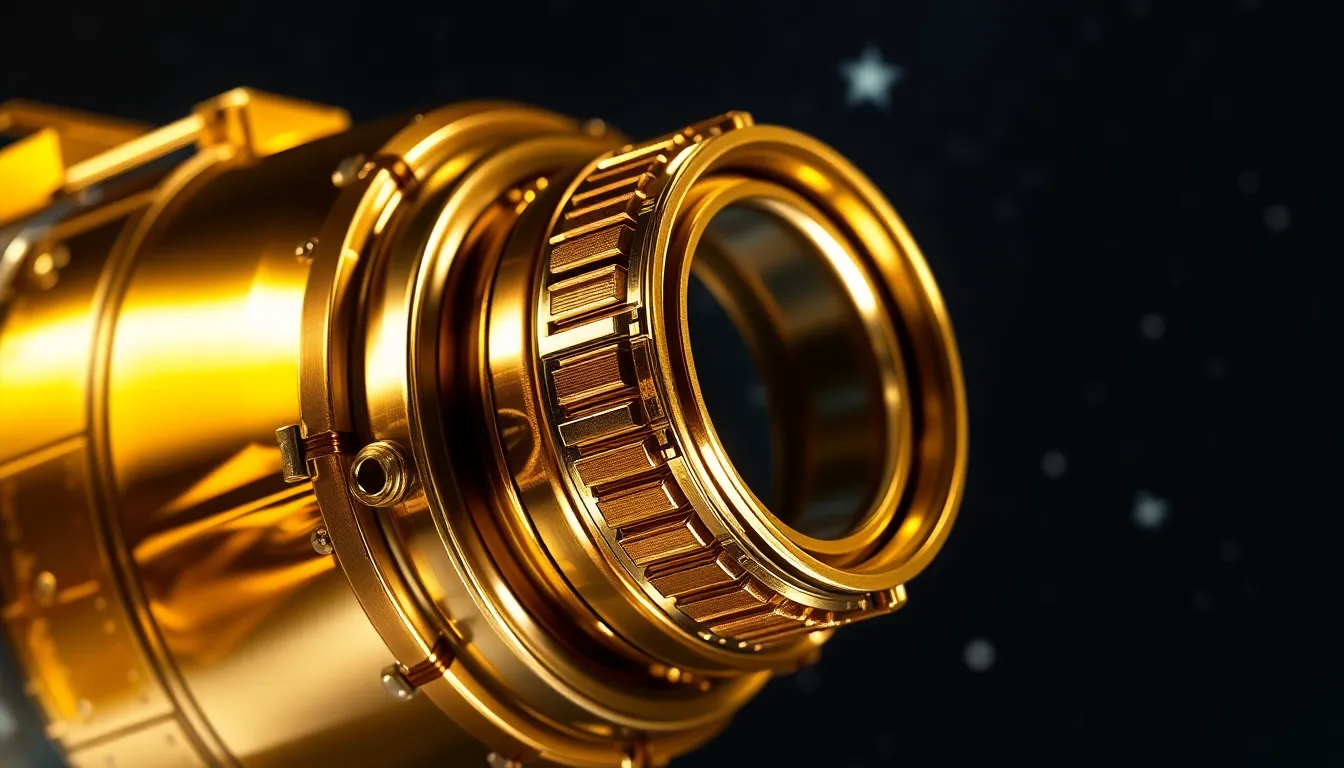Table of Contents
ToggleWhen it comes to space technology, gold isn’t just for bling—it’s a superstar material that’s out of this world. Picture this: while astronauts are floating around in zero gravity, they’re not just wearing shiny helmets for style points. Gold plays a crucial role in keeping their equipment functioning and their bodies safe from the harsh realities of space.
From reflective coatings on satellites to essential wiring in spacecraft, gold’s unique properties make it a go-to choice for engineers. It’s highly conductive, resistant to corrosion, and can withstand extreme temperatures. So the next time you gaze at the stars, remember that those twinkling lights might just be draped in a little golden magic, ensuring our adventures beyond Earth are as smooth as a well-polished trophy.
Importance Of Gold In Space Technology
Gold serves vital functions in space technology due to its unique physical and chemical properties. Conductivity stands out as a primary reason for its use. Electrical connections in spacecraft rely on gold’s high conductivity, ensuring efficient power distribution.
Corrosion resistance is another critical feature. Various space conditions, including vacuum and radiation, can degrade materials over time. Gold, however, remains unaffected, thereby prolonging the lifespan of critical components, such as satellites and instruments.
Reflectivity enhances the utility of gold even further. Satellites often use gold coatings to reflect infrared radiation. This shielding protects sensitive equipment from heat damage and helps maintain optimal operational temperatures.
Durability plays a significant role in gold’s selection. Spacecraft experience extreme temperature fluctuations and radiation exposure. Gold’s ability to withstand these harsh conditions ensures that equipment remains functional and safe throughout missions.
Heater applications also benefit from gold. Some spacecraft utilize gold to help control temperature fluctuations, providing stable conditions for the sensitive technology onboard. Gold’s superior thermal properties protect equipment from overheating.
Aesthetic qualities, while not the main focus, contribute to gold’s appeal in space missions. The striking appearance serves practical purposes, such as visibility against the dark background of space. Its shiny nature aids in identification during assembly and maintenance.
Gold remains an essential material in modern space technology. Its unique characteristics make it invaluable for ensuring the functionality and safety of equipment used in the challenging environment of space.
Properties Of Gold Beneficial For Space Applications

Gold exhibits unique properties that make it invaluable in space technology. Its distinct characteristics enhance functionality, safety, and durability in extreme environments.
Thermal Conductivity
High thermal conductivity stands out as one of gold’s essential features. Effective heat dissipation in spacecraft components relies on this property. Gold efficiently transfers heat away from sensitive areas, preventing malfunctions caused by overheating. Spacecraft often endure extreme temperature fluctuations, so maintaining optimal operating temperatures is crucial. Additionally, gold solder and connectors provide reliable thermal and electrical conductivity. This capability ensures the longevity and performance of critical instruments in the confines of space.
Radiation Resistance
Resistance to radiation also highlights gold’s importance in space applications. Gold’s ability to reflect and absorb harmful radiation protects equipment from degradation. In space, intense radiation can compromise the integrity of materials. Gold coatings on components act as a barrier, preserving functionality over time. Many spacecraft encounter varying levels of radiation exposure, making this property essential. By minimizing damage from cosmic rays and solar flares, gold significantly enhances the lifespan of space technology.
Applications Of Gold In Space Equipment
Gold plays a critical role in various space applications due to its unique characteristics. Its incorporation enhances the reliability and efficiency of equipment traversing the harsh environment of space.
Satellites
Satellites utilize gold coatings effectively to manage heat and protect sensitive components. Reflective gold surfaces reflect solar radiation, minimizing heat absorption, which is essential for maintaining operational integrity. It also prevents damage from temperature fluctuations that can occur in space. Furthermore, gold’s high electrical conductivity improves signal transmission, ensuring data flows seamlessly between the satellite and ground stations. This conductivity significantly enhances the performance of communication systems, making gold indispensable in modern satellite technology.
Spacecraft
Spacecraft rely on gold for numerous operational components, including connectors and wiring. The thermal conductivity of gold facilitates efficient heat dissipation, mitigating the risk of overheating within critical systems. Gold’s corrosion resistance extends the lifespan of wiring and circuit boards, crucial for durability in space conditions. In addition, gold solder enhances electrical connections, ensuring reliable communication between vital instruments. This reliability becomes essential during long-duration missions where any failure could compromise mission objectives.
Advantages Of Using Gold Over Other Materials
Gold offers numerous advantages in space technology. Its exceptional conductivity ensures efficient power distribution in spacecraft systems. Durability is another strong point, as gold withstands extreme temperatures and harsh environmental conditions in space. Additionally, gold’s innate resistance to corrosion significantly prolongs the life of critical components.
Conductive properties greatly enhance overall performance. Gold connectors and solder maintain reliable electrical connections, which are vital for the success of long-duration missions. The ability to effectively dissipate heat prevents overheating, safeguarding sensitive instruments from damage.
Reflective properties serve a crucial role in protecting equipment from solar radiation. Coatings of gold on satellites reflect sunlight, reducing heat absorption and stabilizing onboard temperature. This reflective quality also helps shield delicate instruments from cosmic rays and enhances their operational lifespan.
Weight considerations also come into play. Gold maintains a low weight for its functionality compared to other materials, which is essential for spacecraft design. Its malleability allows for precise application, facilitating the creation of intricate components without compromising quality.
Gold’s unique blend of conductivity, durability, corrosion resistance, and heat management make it an optimal choice over other materials for space applications. Its advantages contribute significantly to the safety and functionality of space technology.
Environmental Impacts And Sustainability
Gold mining and its production can significantly impact the environment. Mining activities can lead to soil erosion, habitat destruction, and water contamination. Efforts toward sustainable mining practices are crucial to mitigate these effects. Decreasing the use of harmful chemicals and employing responsible extraction methods helps protect ecosystems.
Recycling gold presents a sustainable alternative. The process reduces the need for new mining, thereby lessening environmental damage. Approximately 90% of gold used in space technology can be reclaimed from recycled sources, minimizing resource depletion. Advanced recycling techniques ensure that the material retains its essential properties, making it suitable for space applications.
Waste management in the gold industry also plays a role in sustainability. Implementing practices to manage waste effectively can minimize contamination risks. Facilities that focus on reducing their ecological footprint demonstrate a commitment to responsible sourcing and environmental stewardship.
Organizations are increasingly recognizing the importance of responsibly sourced gold. Standards such as the Responsible Gold Mining Principles guide mining operations toward ethical and sustainable practices. Additionally, transparency in the supply chain fosters accountability and encourages environmentally friendly initiatives.
Another consideration is the energy consumption associated with gold production. Utilizing renewable energy sources can reduce reliance on fossil fuels, thereby lowering greenhouse gas emissions. Incorporating renewable energy solutions in mining operations promotes sustainability.
Ultimately, gold’s role in space technology is intertwined with the necessity for sustainable practices. As reliance on this metal in high-tech applications continues, the industry must prioritize environmentally friendly methods. Balancing technological advancement with ecological responsibility remains essential for future developments in space exploration.
Gold’s unique properties make it an essential material in space technology. Its high conductivity and corrosion resistance ensure the reliability of critical systems in harsh environments. By reflecting solar radiation and managing heat, gold protects sensitive equipment, extending their operational lifespan.
As the demand for advanced space exploration grows, the importance of sustainable practices in gold mining and recycling becomes increasingly vital. Balancing technological needs with ecological responsibility will shape the future of space technology. Gold’s role in this field is not just about functionality; it reflects a commitment to innovation that respects the planet.




